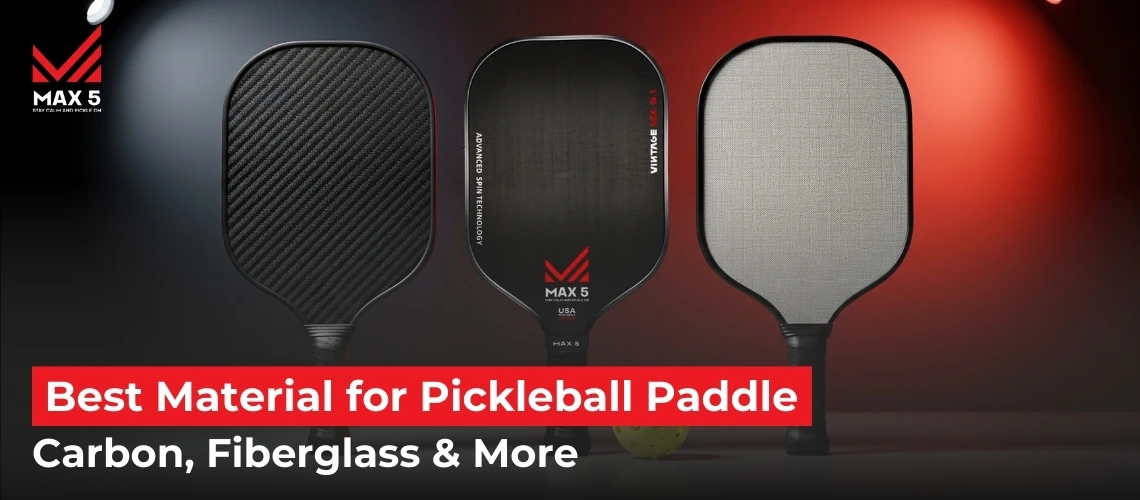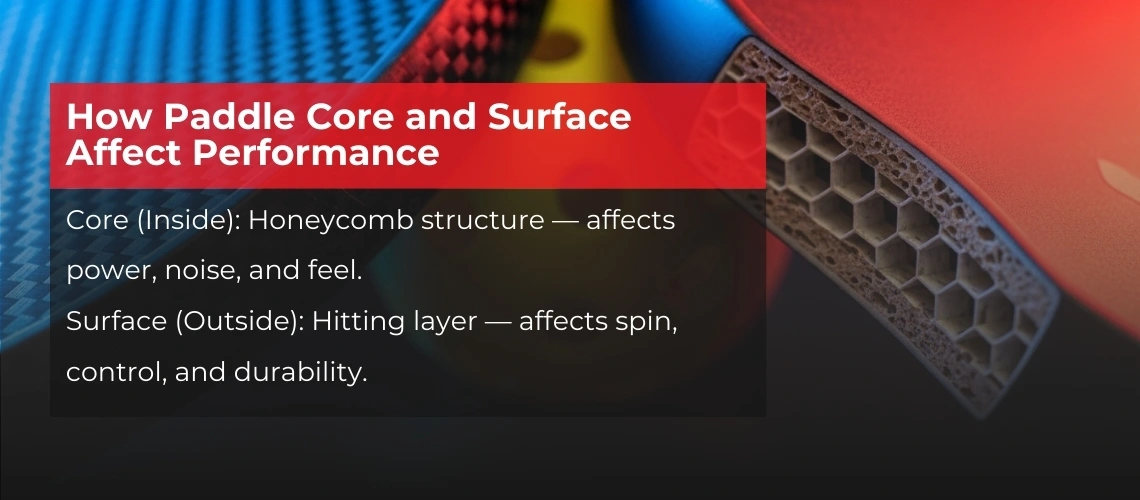
Best Material for Pickleball Paddle: Carbon, Fiberglass & More
Ever hit a ball that just didn’t go where you wanted? Or felt wrist fatigue or sometimes pain after a long match? It is not a difficult question to choose the best material for a pickleball paddle that can solve these problems. Your power, control, spin, comfort, and how long it lasts on the court are always dependent on the material of the paddle. If you have too many choices, it is so difficult to choose the right one. You might be thinking, “What are pickleball paddles made of?” or “Are fiberglass pickleball paddles good?”.
In this guide, we’ll explain the different paddle faces and cores, how they affect your game, and help you pick the right paddle for your skill level, whether you’re a beginner, intermediate, or advanced player. By the end, you’ll understand why MAX 5 paddles are trusted by players for durability, responsiveness, and comfort.
Understanding Pickleball Paddle Materials
Material Matters in Pickleball Paddles
The material of a pickleball paddle affects how it plays, including the paddle weight, its durability, power, and control. For example, wood paddles feel heavier, while carbon fiber paddles are lighter. Polymer cores give a soft, quiet feel, whereas Nomex cores add extra speed and pop.
If you’ve ever wondered why some paddles cost $30 while others cost $200+, the answer lies in the material technology and performance design.
Paddle Core and Surface Affect Performance
A pickleball paddle has two main parts:
- Core (inside): A honeycomb structure that impacts power, noise, and feel.
- Surface (outside): It is a layer where you hit the ball with, which affects spin, control, and durability.
With the right combination of core and surface materials helps you to get the best paddle according to your playing style. If you prefer light, precise shots or powerful, fast hits.
What Are Pickleball Paddles Made Of?
A pickleball paddle consists of two main components:
1. Face Material (Surface)
The outer layer determines touch, spin, and durability.
Options include:
- Graphite paddle
- Fiberglass paddle
- Carbon fiber paddle (Just like Max 5 Paddle)
- Wood paddle
2. Core Material (Inside)
The core affects power, control, shock absorption, and noise level.
Options include:
- Polypropylene core (honeycomb)
- Nomex core
- Aluminum core
- Foam core
Pro Tip: Your face and core choice impacts weight balance, sweet spot, spin potential, and longevity.
Paddle Surface Materials: Spin, Touch, and Performance
1. Graphite – Lightweight and Responsive
Graphite paddles are some of the most popular because they’re:
- Extremely lightweight for quick hand movement
- Responsive, giving players a good feel for the ball
- Durable without being too stiff
- They offer excellent touch and control, making them a top choice for players who like finesse over brute force. Think of graphite as your precision paddle, excellent for finesse shots.
Buyer Tip: Best for intermediate paddle material or players prioritizing accuracy over raw power.
2. Carbon Fiber – High Performance and Precision
Carbon fiber is similar to graphite but even stiffer and stronger. These paddles:
- Provide unmatched precision
- Deliver excellent spin and control
- Used by professional and advanced players
The carbon fiber paddles have a higher price because they offer higher performance. They are ideal for those players who want elite-level consistency and accuracy.
Buyer Tip: Perfect for professional paddle material or competitive players. We recommend the Max’5 carbon pickleball paddle for you in this regards.
3. Fiberglass – Power and Affordability
Fiberglass paddles are:
- Slightly heavier than graphite
- Better at generating power
- More affordable than carbon fiber options
They’re a great middle-ground choice for players who want power and control without breaking the bank.
4. Wood Face – Classic Feel for Beginners
Wood-faced paddles are:
- Old-fashioned, but it is reliable
- Affordable for entry-level players
- Heavier, making them less ideal for fast play
Most serious players eventually move on from wood to modern surfaces.
Buyer Tip: Best for beginner paddle material or casual play.
Paddle Core Materials: Power and Control
1. Polymer Core – Lightweight and Quiet
Polymer cores are made from durable plastic honeycomb. They are:
- Quiet (ideal for communities with noise restrictions)
- Forgiving (ideal for beginners and intermediate players)
- Balanced between power and control
This material is currently the most popular choice among players due to its mix of performance and comfort.
2. Nomex Core – Hard and High-Powered
Nomex is a paper-based resin material that creates a rigid, strong core. It is:
- Very powerful with extra pop
- Durable for long-term use
- Best for advanced players seeking speed and aggression
Note: Nomex is louder and less forgiving, but it is better for aggressive players than beginners.
3. Aluminum Core – Durable and Balanced
Aluminum honeycomb cores are:
- Lightweight, helping with quick reactions at the net
- Durable and long-lasting
- Great for control rather than raw power
These paddles are often chosen by players who value touch and placement over smashing power. Perfect for control-focused intermediate players.
4. Wood Core – Traditional and Budget-Friendly
Wood paddles were the original pickleball paddles, and while less common today, they remain:
- Affordable for beginners
- Very durable but heavy
- Better for casual or recreational play
If you improve your game, the wood core may not be a good option for you. But the wood core is good for those players who are just learning the game.
5. Foam Core – Soft and Comfortable
Foam cores are made from high-density polymer foam. They are:
- Quiet and forgiving
- Offer larger sweet spot
- Absorb shock effectively, reducing wrist fatigue
Great for long matches and comfort-focused players.
Pickleball Paddle Core Materials
Core Material | Characteristics | Best For |
Polypropylene (Honeycomb) | Quiet, lightweight, durable | Control & comfort; indoor/outdoor play |
Nomex | Hard, strong, loud on impact | Power & speed; advanced players |
Aluminum | Durable, lightweight, great touch | Control-focused intermediate players |
Foam | Shock absorption, larger sweet spot, quiet | Long matches, comfort |
| Wood | Heavy, durable, budget-friendly | Beginners or casual play |
Indoor vs Outdoor Pickleball Paddles
- Indoor: Graphite or carbon fiber paddles with softer cores give better control.
- Outdoor: Fiberglass or Nomex-core paddles give more power, withstand harder balls, and handle wind.
Other Features to Consider
1. Grip Materials – Comfort and Control
The grip material can affect how comfortable the paddle feels in your hand. Common options include:
- Cushioned grips for shock absorption
- Leather grips for a classic feel
- Synthetic grips for durability
2. Paddle Weight – Lightweight vs Heavy
- Lightweight paddles: These paddles are easier for quick reactions and less strain on the wrist
- Midweight paddles: They balance power and control, and they are most popular
- Heavy paddles: they are more powerful, but due to their heavy weight, they can fatigue your arms
3. Durability – How Long Will Your Paddle Last?
- Carbon fiber & graphite last longer than fiberglass
- Polymer cores outlast Nomex structurally
4. Performance Characteristics – Power vs Control
- Power players often prefer Nomex or fiberglass
- Control players lean toward polymer or carbon fiber
- Balanced players may enjoy midweight graphite paddles
Performance Factors to Consider
Factor | Graphite Paddle | Fiberglass Paddle | Carbon Fiber Paddle | Wood Paddle |
Power | Moderate | High | Moderate | Low |
Control | Excellent | Good | Excellent | Low |
Durability | Good | Average | Excellent | High (Heavy) |
Spin Potential | Moderate | High | High | Low |
Weight | 7-8 | 7.5-8.5 | 7-8 | 8.5+ |
Price Range | Mid | Mid-High | High | Low |
Tips for Choosing the Right Paddle Material
Beginner Paddles
New players should start with a polymer core and fiberglass face. This combo is forgiving, affordable, and easy to control.
Intermediate Paddles
Players who have developed some consistency benefit from graphite paddles with polymer cores, offering control without losing too much power.
Advanced Paddles
Experienced players often prefer carbon fiber paddles for ultimate precision, spin, and responsiveness.
Our Top Pick: Max 5’s Carbon Paddle
If you’re looking for the best material combination in one paddle, the Max 5’s Carbon Paddle is a standout choice.
- Carbon Fiber Face: For unmatched spin and control
- Polymer Honeycomb Core: Quiet, durable, and responsive
- Lightweight Design: Perfect for quick volleys and long matches
- Durable Construction: Built for players who want performance and longevity
The Max 5’s Carbon Paddle is designed for serious players who want to elevate their game. Whether you’re smashing at the baseline or dinking at the net, this paddle gives you the perfect balance of power and precision.
Buy the Max 5’s Carbon Paddle today and take your pickleball game to the next level.
Conclusion:
Choosing the best material for your pickleball paddle depends on your skill level, comfort, and playing style. Beginners benefit from a polymer core with a fiberglass face, offering forgiveness and control without straining your wrist. Intermediate players often prefer a graphite paddle with a polymer core, providing the ideal balance of power and precision.
For advanced players, a carbon fiber paddle delivers unmatched spin, responsiveness, and pro-level control. The Max 5 Carbon Paddle combines all these advantages: durability, a responsive sweet spot, and effortless handling. With the right paddle, every shot feels controlled, accurate, and comfortable; it can truly change your game.
Frequently Asked Questions
Which material is best for beginners?
For beginners, a polymer core with a fiberglass face is ideal. It provides comfort, forgiveness, and affordability while offering enough control to learn proper technique and enjoy consistent gameplay.
What paddle surface offers the most spin?
A carbon fiber paddle surface generates the most spin due to its textured stiffness. Players seeking superior spin control often prefer carbon fiber for precise shots, advanced control, and competitive play.
Are lightweight paddles better than heavy paddles?
Lightweight paddles are easier on the wrist and allow faster reactions, making them great for control. Heavy paddles provide extra power but may cause fatigue during long matches.
How does core material affect paddle durability?
Polymer cores usually last longer with consistent play, offering balance and control. Nomex cores create more power but can wear faster over time, especially under heavy and aggressive gameplay conditions.
Is carbon fiber or fiberglass better for pickleball?
Carbon fiber paddles excel in durability and control, while fiberglass paddles provide more power and spin. Players seeking lasting performance prefer carbon fiber, while aggressive hitters often choose fiberglass.
What is the best core material for pickleball paddle?
The best core materials are polymer honeycomb, Nomex, and aluminum. Polymer balances power and control, Nomex offers speed and durability, while aluminum gives excellent precision, making it popular among advanced players.
Which paddle do most pickleball pros use?
Most pickleball pros use carbon fiber or graphite paddles with polymer honeycomb cores. These paddles deliver outstanding control, spin, and power, making them the top choice for professional competitive play.

